Quick Tips About Shopping for a Cheap Car
- Mileage is often the primary consideration when used car shopping, but the vehicle’s age is important because parts for older models can be expensive or hard to get.
- You might not get everything you want in a cheap car, but you can focus your search for vehicles with your must-have features.
- A vehicle’s financial impact isn’t limited to how much you pay for it, so consider operating costs like fuel economy when shopping for cars within your budget.
Looking to buy a cheap car? For less than $5,000, it is possible to find reliable transportation in America, but it takes time and careful searching. There are a lot more cheap cars than cheap reliable cars.
So, you will need some help narrowing down your options. When you are shopping on a tight budget, we recommend you take eight factors into account. continue reading as we break down each factor and show you the mechanics of searching for the right, inexpensive used car for you.
1. Mileage of the Vehicle
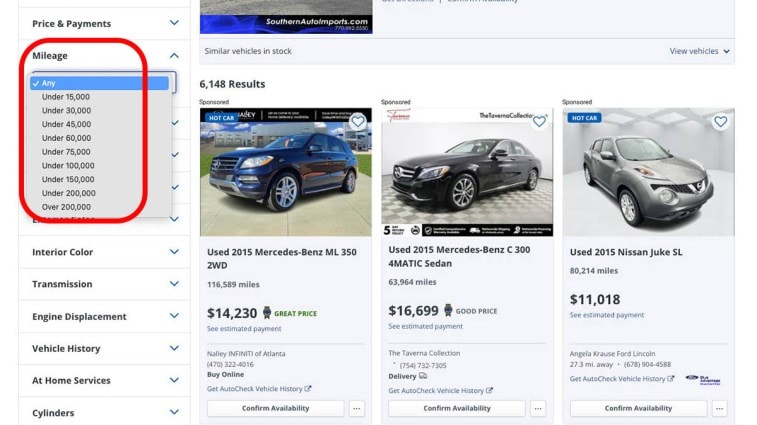
The number of miles a used car has traveled can matter more than a vehicle’s age.
After all, car parts accumulate wear and tear when the vehicle sits still, but they rack it up a lot faster on the move. For reference, remember that drivers log an average of 13,500 miles yearly.
You can easily specify mileage limits within our search tools using the mileage filter. For example, check out this list of Toyota RAV4 SUVs with less than 45,000 miles.
2. Age of the Car
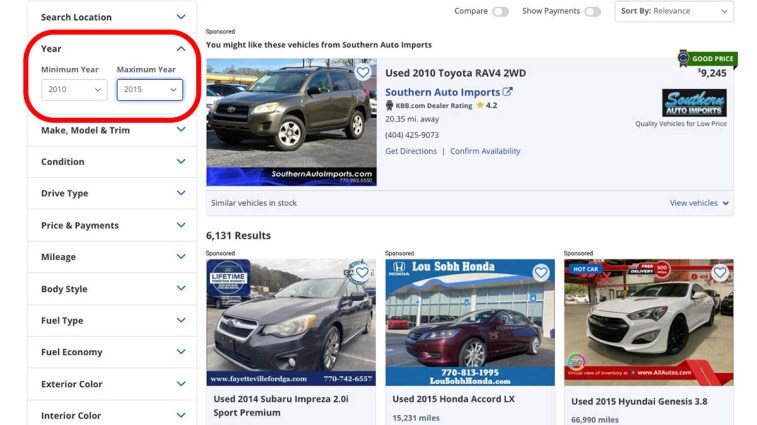
Unless you’re looking at the kind of classics that inspire collectors, older cars will generally be less expensive than new ones. But, past a certain point, the age of a used car adds to the expense of owning it. Finding parts for a model that’s been out of production for a long time gets more challenging.
Cars typically get redesigned every five to eight years. Mechanics will have a relatively easy time finding parts for the current model and the prior model car. Buy one much older than that, though, and you may find it hard to source parts for the car repairs an older vehicle inevitably needs. See our pricing guide to approximate costs for typical vehicle service and repairs specific to the cheap car under consideration.
We recommend you research the car you’re interested in and find out when the automaker last redesigned the model. Use our model-year search tools to ensure you’re only considering a vehicle up to two generations old.
RELATED: How to Buy a Used Car in 10 Steps
You can easily set a range of search years within Kelley Blue Book’s search tools. You’ll see a series of filters you can use to narrow your search on the left side of the screen.
For instance, with the model-year filter, you could limit your search to Jeep Wranglers from model years 2010 to 2015, though it may be difficult to find one under $5,000.
3. Condition of the Car
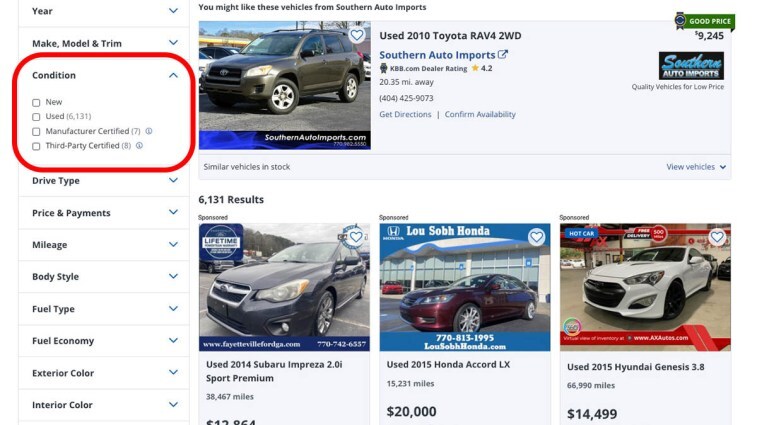
Looking at the condition of a car, 45,000 miles of easy, low-traffic highway driving takes a very different toll on a vehicle than 45,000 miles of heavy-on-the-brakes, stop-and-go, rush-hour commuting.
One of the best ways to determine that a car is in acceptable condition is to stick with manufacturer-certified pre-owned vehicles (CPO). Every manufacturer uses its own standards for certifying a pre-owned car. Dealerships put vehicles through rigorous inspections. They determine what wear and tear seems appropriate for the age and mileage of the vehicle. Certified pre-owned cars often come with the added security of a warranty for used car buyers.
Kelley Blue Book’s search tools allow you to restrict your search to manufacturer-certified used cars.
4. Vehicle History
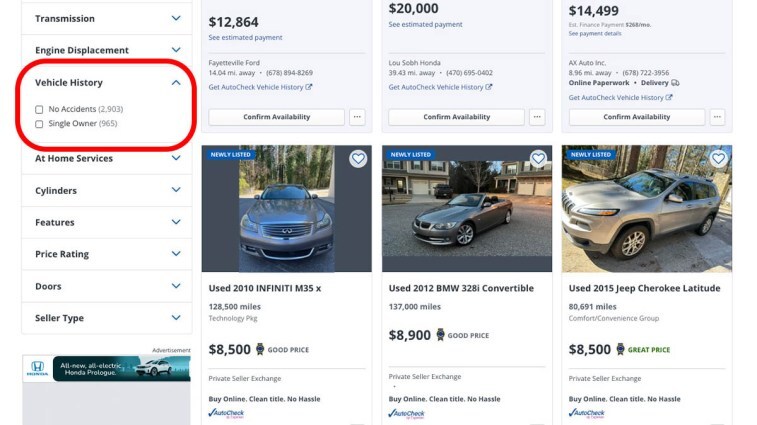
A car that survived a major accident and got repaired may not be as reliable as another incident-free vehicle. It’s also hard to know the car’s history when it used to have several owners.
You can avoid automobiles with accident history and those with several owners when you use Kelley Blue Book search filters. Filters let you select vehicles with no accident history or those with only one owner.
TIP: Whether you’re used car shopping at a dealership or buying from a private seller, we recommend you search the car’s VIN to determine if it has been stolen. the National Insurance Crime Bureau has a free online service to look up any record of insurance theft claims.
5. Features of the Car
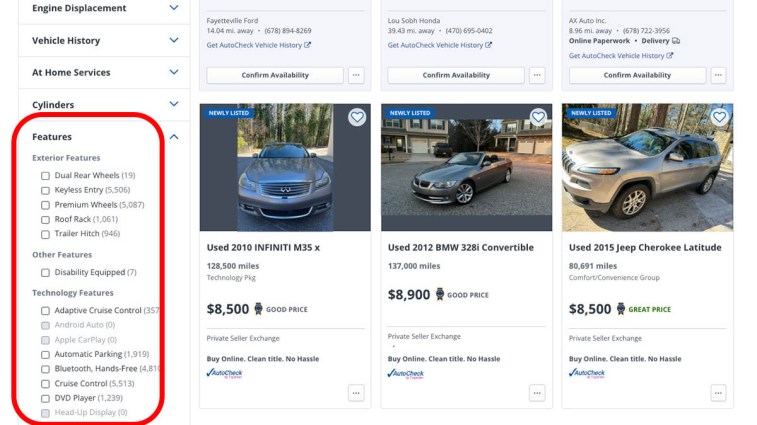
Everyone shops with their preferences and must-haves in mind when searching listings for cars. For example, you may have a long driveway and pets and need a backup camera in a used car for added safety. Perhaps you may be shopping for a pickup and require a trailer hitch.
Kelley Blue Book can sort for those. Here, for instance, is a list of Ford F-150 pickups with keyless entry.
6. Drive Type
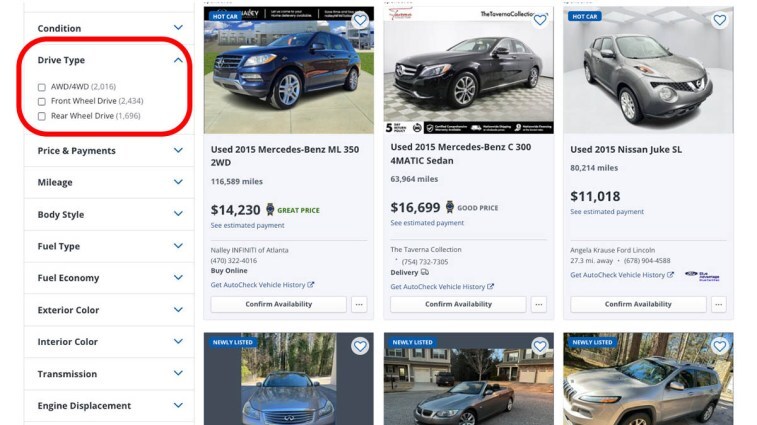
Depending on the weather where you live and how you plan to use your car, you may need to limit your search to all-wheel-drive (AWD) or even 4-wheel-drive vehicles (4WD).
A quick refresher – a car’s engine can power either two or four of its wheels. Each layout has benefits and drawbacks.
RELATED: AWD vs. 4WD: Which is Better?
Cars with 2-wheel drive can power either the front or rear wheels. Front-wheel drive is the most common configuration and works well for most drivers. It places the drive wheels underneath the engine (except in the rare circumstance of a mid- or rear-engine car), where the extra weight gives them enough traction for most driving conditions.
Rear-wheel drive is common to many high-performance cars because it helps balance weight more evenly between the front and rear axles, improving handling. Rear-wheel drive is also the standard for pickup trucks and some larger SUVs.
For more severe circumstances, however, you need power going to all four wheels.
AWD systems can shift power back and forth to each axle (and, with some systems, to each wheel), depending on where it is needed. They tend to cost more than other drive systems.
Usually, they offer the best balance of traction for poor weather circumstances, such as snow, sleet, ice, or rain, and fuel economy for clear conditions.
Four-wheel-drive systems always power all four wheels (though the driver can switch on and off in many systems). Four-wheel drive provides the best possible traction in slippery, off-road situations. Still, it is rarely worth the penalty in fuel economy for drivers who aren’t going to take their vehicle off-road.
Kelley Blue Book search results can be filtered by drive type, as in this search for Honda vehicles with AWD or 4WD.
7. Fuel Economy
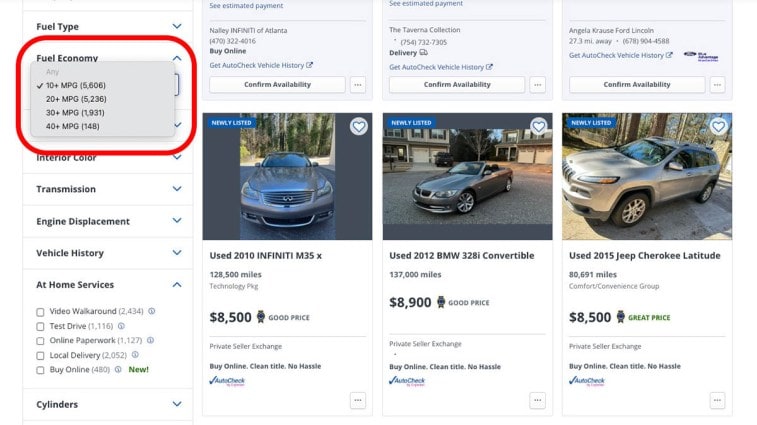
The up-front cost of a car is just the first factor in how it impacts your finances. Fuel costs are a long-term concern the entire time you own the vehicle.
Kelley Blue Book searches allow you to filter for specific fuel economy targets – such as this search for Honda vehicles that get at least 30 mpg combined.
TIP: Even some cheap cars use costlier, high-octane fuel, so learn what type of gas the vehicle requires before buying so you can factor that cost into your budget. Premium fuel costs about 80 cents more per gallon than regular unleaded, or $12 more for a 15-gallon fill-up.
8. Price Rating
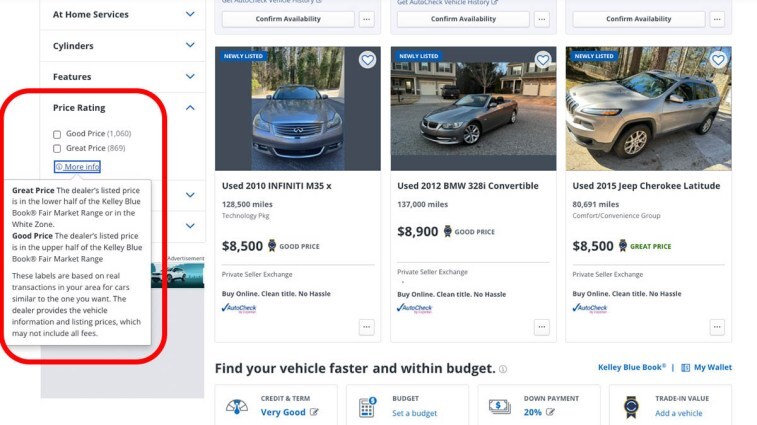
Lastly, you’ll need to ensure you’re not overpaying, even when a vehicle is within your price range. Kelley Blue Book makes it easy to determine what is a fair price.
On KBB.com, listings for used cars show prices within the fair market range for make, model, condition, and mileage. But in the upper half of that range, listings will be marked with a “good price” ribbon in the upper right corner of the listing. Those with a price in the lower half of the fair market range will appear with a “great price” ribbon.
You can specify that you’d only like to see cars with good or great prices in your Kelley Blue Book search results, as seen in this search for Kia vehicles with great prices.
Related Cheap Car Buying Stories:
Source link

